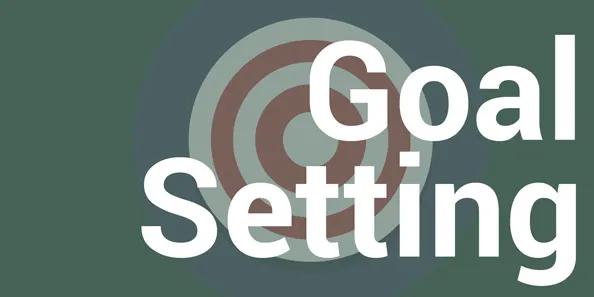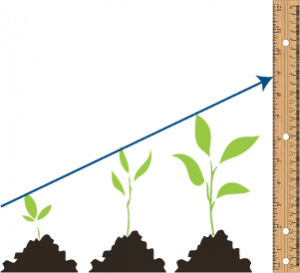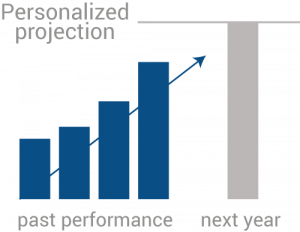The fundamental purpose of setting school improvement goals is to assess the effectiveness of improvement efforts. The utility of the school improvement process rests on the inferences one can draw from meeting a goal. For example, a typical school improvement goal may be “increase the percentage of students meeting standards in grade 4 reading by 5%.” While this type of goal is specific and concise, the results will provide little to no information as to the effectiveness of improvement efforts. Why? Because increasing grade 4 reading by 5% is likely an arbitrary goal that is unrelated to school performance and not evidence-based.

Focus on Student Growth
While we all agree that raising proficiency levels of students is the long-term goal of schools, its sole use as an annual school improvement metric is inadequate. To scientifically and equitably assess improvement efforts, one must focus on measuring student growth, not aggregate improvements in proficiency.
 Focusing school improvement goals on student growth overcomes two major challenges often cited with the use of proficiency rates to judge school improvement efforts. First, measuring growth at the student level removes confounding factors (different groups of students, demographic shifts, cohort effects, differential standards across grade levels, etc.) that create variation in proficiency rates unrelated to school performance. Second, many school improvement efforts target students that are well below or well above the proficiency standard, making it likely that proficiency rates will remain unchanged despite student growth exceeding expectations.
Focusing school improvement goals on student growth overcomes two major challenges often cited with the use of proficiency rates to judge school improvement efforts. First, measuring growth at the student level removes confounding factors (different groups of students, demographic shifts, cohort effects, differential standards across grade levels, etc.) that create variation in proficiency rates unrelated to school performance. Second, many school improvement efforts target students that are well below or well above the proficiency standard, making it likely that proficiency rates will remain unchanged despite student growth exceeding expectations.
Setting improvement goals based on last year’s percentage from the same or previous grade is a moving target. By measuring individual student growth as opposed to aggregate proficiency, confounding variables are mitigated to an ignorable level since the exact same set of students is analyzed against an equated set of standards.
The distinction between growth and proficiency is gaining national attention from policy makers and shifting best practices. Researchers and policy makers now recognize that student growth is a more equitable approach to assessing improvement efforts. As a result, student growth is likely to become a significant factor in school accountability for the vast majority of states.
Use Projection-Based Goals
There are numerous ways to set goals related to school improvement. A best practices approach is rooted in individual student-level projections. The methodology used to set projections is what distinguishes competing approaches.
 The most sophisticated approach to setting goals uses advances in predictive analytics to project achievement at the individual student level. Predictive models generate a personalized projection for each student based on his/her individual past performance. Model projections serve as personalized achievement markers for individual students to outperform.
The most sophisticated approach to setting goals uses advances in predictive analytics to project achievement at the individual student level. Predictive models generate a personalized projection for each student based on his/her individual past performance. Model projections serve as personalized achievement markers for individual students to outperform.
Since projections are anchored to individual students, aggregate goals can be set for any subgroup of students. Such information can be linked to district resource allocations so informed decisions can be made regarding programs and other investments and their effect on student outcomes.
- Define, identify, and group students that will be served by a particular school improvement intervention.
- Articulate, implement, and document the improvement efforts that will take place during the school year.
- Compare the margin by which actual results outperform projected results against a desired effect size and statistical significance.
Don’t forget about Proficiency
While measures of student growth should be used to evaluate the impact of school improvement efforts, don’t forget that proficiency is the long-term goal for students. Be cognizant that the only way in which one can close achievement gaps is for students that are behind to grow faster than students that are ahead. It’s a mathematical fact that if all students continue to grow at equivalent rates in the future, achievement gaps will persist in perpetuity. Therefore, if a particular school improvement effort targets low proficiency students, consider choosing a more rigorous target consistent with a higher growth effect size.
While setting school improvement goals can seem daunting, in the end it is simple. Regardless of the methodology or approach your school district uses, stay focused on measuring growth when evaluating the impact of improvement efforts. Resist the temptation of setting arbitrary improvement goals such as “increase by 5 percent.” Arbitrary targets will likely produce inaccurate inferences regarding the effectiveness of improvement efforts.

